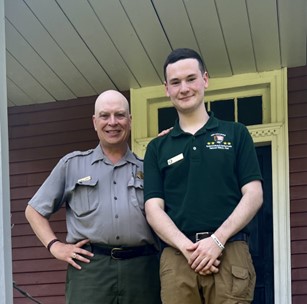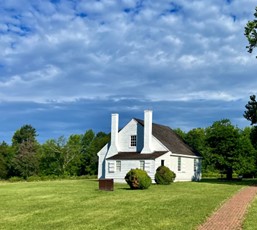My Summer Where “A Hundred Thousand Fell”: Interning at Fredericksburg and Spotsylvania National Military Park
by Eric Willersdorf | | Friday, August 18, 2023 - 14:21

The seventy-five square miles that comprise the Wilderness guided a heavy hand over three of the four years of America’s Civil War. Between 1862 and 1864, turmoil was commonplace from the banks of the Rappahannock at Fredericksburg, west to Wilderness Tavern, and beyond. The battles of Fredericksburg, Chancellorsville, the Wilderness, and Spotsylvania Courthouse resulted in more than one-hundred thousand casualties. Thousands of young men were ripped from the Earth, the mortality of mankind soberingly looming long after the last shots of these battles had been fired.
Reminders of this loss still populate the landscape. The Fredericksburg National Cemetery rests atop Marye’s Heights, a place twice scarred by war and bloodshed. Two streets away, the Fredericksburg City Cemetery provides similar posthumous accommodations for the Confederate dead. Monuments accompany drivers along the Plank Road, now Route 3, aide-memoires to both a cause won and lost. For scholars of the Civil War, the feeling of loss hangs in the air, struck between the confluence of two great rivers and the countryside of Virginia. Visitors to Fredericksburg and Spotsylvania National Military Park are tasked with reckoning with this landscape of loss and tragedy. But it is the role of the National Park Service’s interpretation branch to assist in this reckoning.
I had the immense pleasure of interning within Fredericksburg and Spotsylvania’s interpretation division this summer, where I gained an invaluable skill set that will undoubtedly serve me beyond my academic career. Fredericksburg and Spotsylvania National Military Park enjoys a unique role within the Civil War battlefield network. The park’s interpretation branch serves as the historical custodians of four major battlefields, two historic homes, a church, and several other dependencies pertinent to the story of the region’s role in the Civil War. As a result, I was able to work at a variety of sites, with a large cross-section of National Park Service professionals.
With such an inventory of sites, the park brings on a sizable class of interns each summer. I was very proud to be one of eleven interns, all passionate about history and willing to support each other at every step. The environment created and fostered by park staff and my fellow interns was always encouraging, fun, and professional. This is certainly an aspect I am immensely thankful for.
I worked at the Chancellorsville Battlefield Visitor Center, Ellwood Manor on the Wilderness Battlefield, and the “Stonewall” Jackson Death Site. It was a pleasure to work at each of these sites and interpret their stories for visitors. I was expected to greet visitors, answer any questions they had about the site, and develop and deliver programs that pertained to the site. Program development was among my favorite aspects of the internship. Park administration entrusted all interns with creating meaningful and holistic programs that could be presented to visitors, complementing their experiences while also providing us with critical public engagement experience. Rangers, fellow interns, and park administration were also willing to assist in this program development and were eager to receive similar feedback from me.

Although I worked within the National Park Service ranks, I never felt like I was just an intern. I always felt I was an equal to those I worked with, regardless of their tenure and position. I was filled with immense pride when I was referred to as a “colleague” by the Rangers I had come to look to for guidance. I have always felt relatively comfortable with public speaking and general conversing, but the confidence instilled in me by the park staff undoubtedly extended this comfort.
My lifelong interest in cartography and mapmaking was complemented by my experience at the park. I developed and presented a program entitled “Unsung Engineers: Mapping the Civil War,” which discussed the cartographers and mapmaking technologies at the disposal of both Federal and Confederate forces. The advice and primary sources provided by Park Ranger Frank O’Reilly made this undertaking was possible. With a gap in cartography research present at the park prior to my arrival, it became a passion project to fill this void and truly leave my mark.
The compliments I received regarding my program, from Rangers and visitors alike, made the time-consuming work of information sourcing, writing, and revising well worth it. Bridging my passion for maps and Civil War history made this particular aspect of my internship especially fulfilling. I have no doubt any historical interest could be supplemented by the array of resources offered by Fredericksburg and Spotsylvania.In addition to my maps program, I also presented battle overview and memory programs at the Chancellorsville Battlefield Visitor Center. My “Chancellorsville in Memory” program discussed the romanticization of General “Stonewall” Jackson’s wounding, the rise of the Lost Cause Myth, and the monumentation of the Civil War. This program required the delicate handling of the background of individual visitors and a preliminary heed to their beliefs. I complemented this program by presenting questions to visitors: Who or what has influenced your beliefs of the Civil War? How have these beliefs evolved over time? Powerful conversations routinely stemmed from these questions, and I gained valuable insight into the visitor experience.
The conversation of memory certainly extended to the Jackson Death Site, the farm office where “Stonewall” Jackson died eight days after his wounding. The Death Site, in many ways, is the ground zero of the Lost Cause Myth still prevalent in Southern culture and only recently popularly challenged. I felt I was entrusted with an important task in providing interpretation for this place.
Those without a voice, or name in many cases, were my first priority in contextualizing the Death Site. The farm office resides on what was once the 750-acre Fairfield Plantation, where more than fifty enslaved laborers once lived. It is easy to overlook its previous condition given that the plantation's main house and its dependencies, aside from the farm office, have disappeared with time. But a lack of physical evidence does not excuse incomplete interpretation, an aspect I explained with each visitor interaction. It was refreshing to see so much interest in the stories of these enslaved laborers, reinstating a degree of dignity these individuals were never afforded while they were alive.
I took similar measures at Ellwood Manor, a property that once comprised five thousand acres and enslaved more than a hundred individuals. Narratives of self-emancipation grounded my plantation life program there, an aspect of the home’s history scarcely discussed prior to contemporary contextualization.
I was also fortunate enough to be trained in historical weaponry firing, in particular a twelve-pound field gun and a Mississippi rifle. Dressing in period clothing and being able to demonstrate these technologies was certainly a highlight of the internship. Living history seemed to especially appeal to younger visitors, breaking the mold of a static battle painting-based presentation. Also appealing to these younger visitors was the Junior Ranger program offered by the park. It was very fulfilling to assist in answering questions and understanding the thought processes of our future Civil War scholars and National Park lovers!Spending the summer at Fredericksburg and Spotsylvania was an experience I will never forget. The connections I made and the skills I was able to develop will serve me throughout my academic and professional career. From watching Independence Day fireworks atop Marye’s Heights, to quiet moments at Ellwood, watching the leaves of the grand oaks sway in the wind, the park will always be special to me. I appreciate the time and effort taken by Fredericksburg and Spotsylvania staff to create the ideal summer for my fellow interns and I. In addition, I am overwhelmingly thankful to Brian Neumann (the Nau Center’s managing director), Professor Caroline Janney, and all others at the Nau Center for Civil War History. The opportunities and support they provide students is first rate, and I always felt I was valued as both a student and scholar. With limited prior knowledge of the federal job market and National Park Service system, I now feel much more equipped and prepared for my future. Given my experiences here, I imagine for myself a future in public history, and quite possibly the National Park Service. The events of the Wilderness region will always have a sobering effect, but the great times I had at this park will never be forgotten. The relationships I have forged and the abilities I have discovered here will accompany me long after my time at the University of Virginia.
